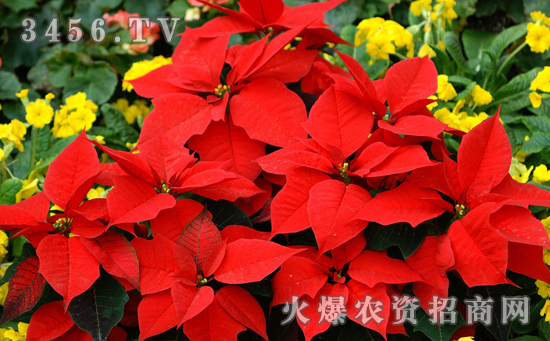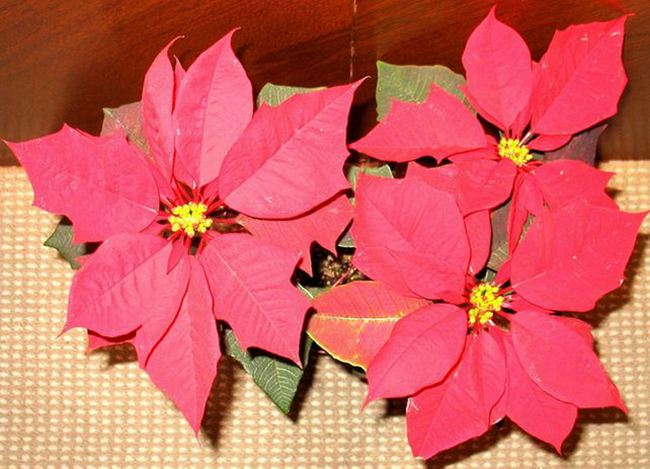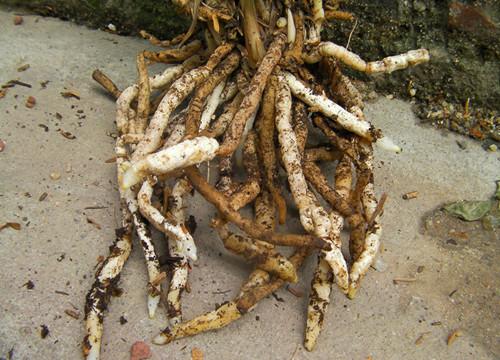What are the diseases and insect pests of poinsettia? How to prevent and cure?
Poinsettia common diseases are Pythium, Botrytis cinerea, powdery mildew, Rhizoctonia, common pests are whitefly, thrips, spiders (mites), fungal mosquitoes.
(1) the prevention and control of Pythium. Keep the basin soil moist to avoid drying, excessive watering and high salinity; check the roots regularly. If the basin soil dries, it should be watered thoroughly before fertilization. If it is found that the root may be injured, irrigate with 1000 times liquid thiophanate solution.
(2) Prevention and treatment of Botrytis cinerea. Keep it ventilated and low wet, especially before harvest; top irrigation can only be done in the morning; spray with Klu 800 times liquid, note that it can only be used after rooting.
(3) Prevention and treatment of powdery mildew. Keeping the ventilation smooth and the humidity slightly low, applying 1000 times of aldicarb every 5 days for 3 times can well prevent the occurrence of powdery mildew, and bracts can be applied again after coloring.
(4) Control of Rhizoctonia. The salt level in the matrix should be maintained and the water content should be moderate. 1000-fold carbendazim and 1000-fold chlorothalonil were sprayed and staggered every 4 weeks.
(5) Control of whitefly. The application of aminoproflurin in soil can also effectively inhibit the development of powdery mildew population. The use of safer products are once net, imidacloprid, Jiqi, etc., pay attention to the use of double dosage before large-scale use, to see if it will cause harm.
(6) Control of thrips. Use 1200 times liquid vegetable to control, or use 1000 times liquid avermectin to control.
(7) Control of red spider (mite). Spray with 2000-fold solution or 3000-fold solution of mirax, once a week for 4 weeks.
(8) Control of fungal mosquitoes. Most of this pest occurs in the early stages of reproduction and during the first seedling period, and spraying the floor with a common broad-spectrum insecticide every week can greatly reduce the population.
What are the common diseases and insect pests of poinsettia? the prevention and control methods of poinsettia diseases and insect pests
Poinsettia has a beautiful shape, high-end and elegant temperament, which is very suitable for traditional Chinese festivals and seems to be tailor-made for China. As poinsettia blossoms at the time of New Year's Day and Spring Festival, there is a beautiful implication of celebrating the whole world and wishing new life together. However, in the process of family breeding, there will always be some unsatisfactory places to affect the ornamental effect of poinsettia. So what are the common diseases and insect pests of poinsettia? The following is to introduce the prevention and control methods of diseases and insect pests of poinsettia.

What are the common diseases and insect pests of poinsettia
Common diseases and insect pests of poinsettia include Botrytis cinerea, root rot, leaf spot and whitefly. These diseases not only affect the overall household ornamental effect of poinsettia, but also even take the life of poinsettia when it is serious, so we should pay special attention to the diseases and insect pests of poinsettia.
Control methods of diseases and insect pests in poinsettia
Grey mold disease
Botrytis cinerea mainly occurs in winter, when poinsettia blossoms. Once it is rainy and wet, it can harm inflorescences, bracts, leaves and branches of poinsettia. Generally speaking, water-immersed disease spots begin to appear from the tidbits. After that, the disease spot was covered with a robe of pathogens, and the pathogens continued to spread to the bracts. The bracts produced water-immersed discolored spots at the initial stage, and then gradually expanded into irregular shapes, and the pathogens extended to the branches, producing yellowish brown to brown spots on the branches. in the later stage, the disease spots were obviously sunken dark brown, and in severe cases, the disease spots were dry. The pathogen is Botrytis, which can live on dead plant tissue or other organic matter and has a wide range of parasites. It can survive at a temperature of 0-38 ℃, and it exists as long as there is moisture. If the greenhouse is too wet, cold and lack of light, after 1-2 days, the pathogens will produce a large number of robes free in the air and begin to infect plant tissue.
Prevention and control methods: make use of the closed facilities to create an ecological environment with high temperature and low humidity to control the occurrence and development of Botrytis cinerea. Most of the indoor humidity of the facility is higher than 90% at night. after pulling in the morning, the vents should be opened immediately to ventilate and drain moisture, reduce the indoor humidity, and control the development of the disease with a lower temperature. When the indoor temperature rises and accelerates after 9 o'clock, close the vents and quickly raise the indoor temperature to about 32 ℃.
Root rot disease
Root rot and stem rot can be infected into adult plants, or in the seedling bed stage, resulting in serious losses. Generally, the occurrence is more serious in the high temperature season, and it is also very easy to occur when the cultivated soil water content is high. The phenomenon of wilting appeared in the early stage of the plant, but if the base of the stem was examined, the phenomenon of light brown constriction could be seen, but there was no corruption or hydrolysis in the infected plant, and then the disease spot gradually spread upward, and the wilting phenomenon became more and more serious, and the disease spot was slightly sunken in yellow brown. In the later stage, the tissue of the disease spot disintegrated, causing the plant to wither to death due to serious lack of water, and sometimes the whole plant was yellowed in water, resulting in decay and death. The white hyphae can be seen near the ground and can be extended to the cultivated soil in severe cases. When the root is sick, it often causes root rot, which affects the normal growth of the plant at the initial stage and leads to death in serious cases. The main pathogens are Phytophthora, Rhizoctonia solani, Pythium and so on. When salt accumulates on the surface of the medium, Pythium appears when poinsettia grows up, and it may invade when cutting, and deteriorate when the environment is suitable for reproduction, resulting in root rot and death; high temperature and excessive irrigation (stress conditions) can cause damage to Phytophthora.
Prevention and control methods:
1. Implement crop rotation. The mildly diseased fields were rotated every other year, and the seriously diseased fields were rotated at intervals of 3-5 years.
2. Deep ploughing and soil improvement, increasing application of organic fertilizer, rational drainage and irrigation to enhance disease resistance.
3. Strict seed selection and elimination of unqualified seeds. Mix seeds with 50% carbendazim wettable powder at 0.5% of seed weight.
4. Spray the stem base of peanuts with 1000 times of carbendazim wettable powder, 25-30 kg per mu each time.
Leaf spot disease
Leaf spot disease mainly occurs in spring and summer, and the disease spot mostly occurs from the old leaves. In the early stage, purplish red to brown spots were produced on the leaves, and the disease spots were nearly round to irregular, and then the disease spots gradually expanded, and most of the disease spots could heal each other to form a large disease spot, and in the later stage, the center of the disease spot gradually changed to grayish brown. In severe cases, the lesion tissue is gangrenous, causing the leaves to twist and dry up.
Prevention and control methods:
Timely removal of diseased tissue, centralized burning; crop rotation (soil can be changed in the greenhouse); not suitable for plant spraying; spraying from the early stage of the disease to prevent the spread of the disease.
Whitefly
The main pests of poinsettia are whitefly, leaf mite, thrips and so on. The adults and larvae of whitefly prefer a dense shady environment and cluster on the upper leaf back of poinsettia to suck juice with prickle mouthparts, which makes the leaves fade or appear chlorotic spots, affecting photosynthesis and leading to poor plant growth. Honeydew excreted by worms often causes mildew. Adults have a yellowing tendency. The Eclosion time begins at 6 o'clock in the morning, with the highest Eclosion from 7 am to 8 am and the lowest at night. The first instar mobile larvae of whitefly are the most vulnerable, followed by rigid Eclosion adults, which are sensitive to pesticides and suitable for spraying control. Whitefly usually occurs at high temperature and low humidity, and the peak period is from late September to late November. The most suitable prevention and treatment period is late September, and the spraying time is 6-10:00 in the morning.
The main diseases and insect pests of poinsettia and its control are evergreen shrubs of Euphorbiaceae, whose flowering period coincides with New Year's Day and Spring Festival. the bracts are bright red, bright and soft, and are very popular among people. they are important commercial potted flowers in Europe, America, Japan and Taiwan of our country. at present, it has become a large potted plant species with low investment, quick effect and high income in the domestic potted flower market. However, a variety of diseases and insect pests are easy to occur in the process of production and cultivation, if reasonable control measures are not taken in time, the plant will be seriously damaged and lose its ornamental value.
1. Main diseases and insect pests and their occurrence conditions 1. The symptoms and occurrence conditions of the main diseases (1) in the early stage of powdery mildew infection, there were spots similar to pesticide residues in leaves and bracts. Then, powdery mildew spread rapidly, typical white mildew appeared on the surface of the plant, and the infected tissue died. The symptoms of powdery mildew first occur on the back of the leaves, and green patches often appear on the surface of the leaves. The pathogen is leveillula clavata of powdery mildew, which harms leaves, floral organs and tender shoots. It produces white sticky powdery mildew layer at the initial stage and turns gray at the later stage. The spores of powdery mildew spread easily with the plants in the air. The disease can occur throughout the production season of poinsettia, of which spring or late autumn is its high incidence season. The disease is easy to occur in high temperature and humid environment or excessive application of nitrogen fertilizer and lack of calcium or potassium in the soil. Powdery mildew is easy to spread rapidly in cold, high humidity and large temperature difference between day and night. (2) Botrytis cinerea is the most common disease in poinsettia cultivation. Poinsettia may appear throughout the long season, and all parts of the plant may be infected. It mainly occurs in winter, when poinsettia blossoms. In case of rainy, wet and sunless weather, it often gets out of hand. It mainly harms inflorescences, bracts and shoots of poinsettia. Generally, water-immersed disease spots appear from the inflorescence, then gradually expand, and the diseased tissue turns brown to black and rotten. Under humid environmental conditions, a layer of gray to grayish brown mold is formed on the surface of the later stage, and the disease spot is covered with a layer of pathogenic conidia. The pathogen continued to spread to the bracts, which produced water-immersed faded spots at the initial stage, then gradually expanded into irregular shape, and the floral organs became brown, rotted and exfoliated after infection. The pathogen extended to the branches and produced yellowish-brown to brown spots on the branches. in the later stage, the spots were obviously sunken black-brown, and in severe cases, the spots were dry and completely lost their ornamental value. When infecting bracts, red bracts become lavender leaves when they become infected. Young plants sometimes get sick near the surface of the cultivation medium. Under the condition of high air temperature, a gray hairy mold will be formed on the decaying tissue, that is, the conidiophores and conidia of the pathogen. There will be a kind of black rot on the mature branches, which will develop around the stems and branches, causing the leaves on the damaged surface to wilt. The pathogen is botrytis cinerea pers. The pathogen is almost all over the greenhouse. It can live on dead plant tissues or other organic substances. It is easy to grow and develop in succulent, aging and injured tissues, and parasites widely. It exists as long as there is moisture, but it prefers cool temperatures, which tend to occur at low temperatures and high humidity (relative humidity of 90% to 100%).
- Prev

The method of regulating the florescence of poinsettia culture
Poinsettia blossoms from November to December under natural light conditions, and it is necessary to deal with it if it wants to blossom earlier or later. Short-day treatment is mainly carried out in advance of flowering, that is, when the plant is basically or completely formed, the plant is covered with a small arch shed and black film, and pay attention to close shading.
- Next

Senior orchid friends share the use of these two kinds of plants to raise orchids, which can make orchids have many buds, strong seedlings and flowers.
If orchids want to grow well, they must first grow roots, as flower growers all know, because orchids are organs that absorb and store water and nutrients. Only when orchids are strong can they absorb and store more water and nutrients to supply orchid leaves. Only when orchids are rich in nutrients, can orchids sprout more, seedlings strong and flowers multiply. Then here comes the problem.
Related
- Fuxing push coffee new agricultural production and marketing class: lack of small-scale processing plants
- Jujube rice field leisure farm deep ploughing Yilan for five years to create a space for organic food and play
- Nongyu Farm-A trial of organic papaya for brave women with advanced technology
- Four points for attention in the prevention and control of diseases and insect pests of edible fungi
- How to add nutrient solution to Edible Fungi
- Is there any good way to control edible fungus mites?
- Open Inoculation Technology of Edible Fungi
- Is there any clever way to use fertilizer for edible fungus in winter?
- What agents are used to kill the pathogens of edible fungi in the mushroom shed?
- Rapid drying of Edible Fungi

